#Freshwater gobies
Explore tagged Tumblr posts
Text
The eleotrid clade of gobies are popular aquarium fishes down under, where a number of species inhabit the freshwaters. As a clade of fishes, the eleotrids are underappreciated by aquarists outside of Australasia. One of the three relatively popular species in the aquarium trade, is the visually striking Hypseleotris compressa, the empire or carp gudgeon, also known as the empire fish.
The range of the H. compressa extends from the northern half of mainland Australia in the south, and up into parts of nearby New Guinea. This stunning goby inhabits slow-flowing and still freshwaters, extending only into the low salinity reaches of estuaries, meaning that this is a freshwater fish. There it lives among aquatic plants and woody, submerged debris, and forages for mostly tiny prey amongst detritus, leaf litter, and vegetation.
According to sources, H. compressa measures up to 12 centimeters or almost 5 inches in length. Although I have never seen one exceeding 3 inches, and a more typical size would be 5 centimeters, or 2 inches. Male H. compressa establish territories in which the females spawn, and the males both guard and tend to their nests until hatching occurs. Spawning occurs during the warmer months. The spawn and hatchlings are tiny, and as far as I know, they have never been reared in the aquarium.
In Australian English, the eleotrid or sleeper gobies are colloquially known as the 'gudgeons', although this word, ironically, first referred to a demersal, northern hemisphere carp of the genus Gobio, that was as familiar to the first white Australian settlers, as are the eleotrids to their naturalized descendants. Within the tree of life, gobies are only very distantly related to the carps, and the eleotrid gobies are very successful in the Antipodean freshwaters.
The type locality for H. compressa is the Clarence River of subtropical New South Wales. There the pH is about 6.7 to 7.7, depending on the time of the year, and the average pH is close to 7. More generally, the rivers and creeks in the surrounding Clarence-Moreton bioregion, have yearly average pH values, from 6.6 to 7.8. as regards their water temperature, they are usually 15 to 30 degrees centigrade.
The iconic and multi-volume Baensch freshwater atlas, claims that this species tolerates temperatures of 10 to 30 degrees. This is not very inaccurate but exposure to ambient temperatures as low as 10 degrees, is both seasonal and temporary. Some sources claim this fish tolerates temperatures as high as 35 degrees centigrade, but temperatures in the creeks where H. compressa lives, are not normally this warm, and it should not be attempted in the aquarium.
H. compressa and similar gobies are carnivores. This species consumes insects and other tiny arthropods, primarily cladocerans and copepods, and is regarded as zooplanktivorous. This fish willingly consumes defrosted foods of an appropriate nature. Sources claim this species eats algae, but this seems unlikely to be deliberate given the general diets of Hypseleotris sp. gobies. They do ingest detritus whilst they are feeding, so the merely incidental ingestion of algae is likely in H. compressa and it's kin.
As a predator, H. compressus is not a danger to adult community fishes, although it is known to eat fish fry, including acts of cannibalism. It is a peaceful aquarium denizen, but such 'gudgeons' do prefer a quiet tank without boisterous, demersal tankmates, such as very active catfishes or loaches. The male fish should not be cohabited together.
#Hypseleotris compressa#empire gudgeon#empire goby#carp gudgeon#carp goby#empire fish#freshwater gobies#misunderstood fish#australian fishes
0 notes
Text
My nano aquarium is clean at last!
#aquariumblr#freshwater fish#freshwater aquarium#nano fish#fish community#fishblr#pygmy cory#ember tetra#neon tetra#bumblebee goby#sparkling gourami#nymphaea lotus
8 notes
·
View notes
Text

Sleepy Cod - is a member of the Gudgeon gobies family and is native to Northern Australia and central-southern New Guinea. It inhabits rivers, creeks and billabongs, usually in quiet or slow-flowing water among vegetation, around log debris or beneath undercut banks. It feeds on on insects, fishes and crustaceans. It can reach a maximum length of 45 cm (17.7 inches). https://www.redbubble.com/shop/ap/165468017
2 notes
·
View notes
Text
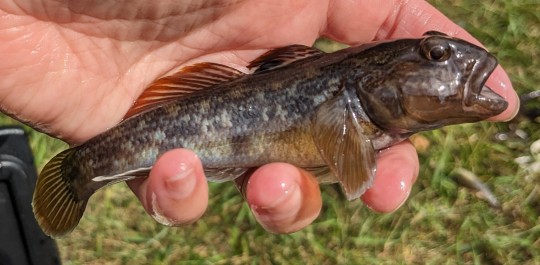
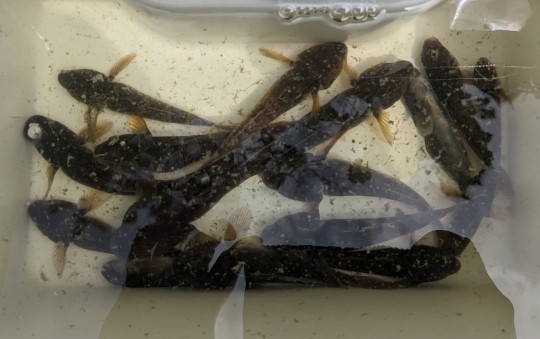
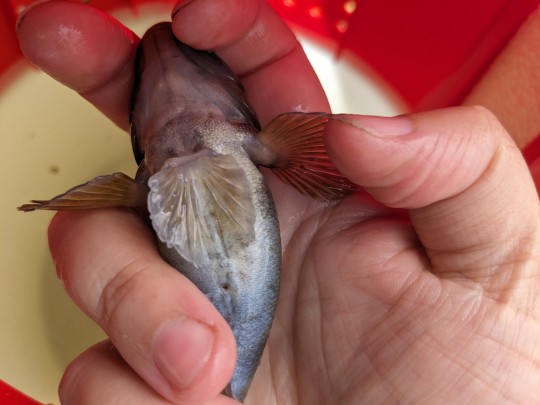
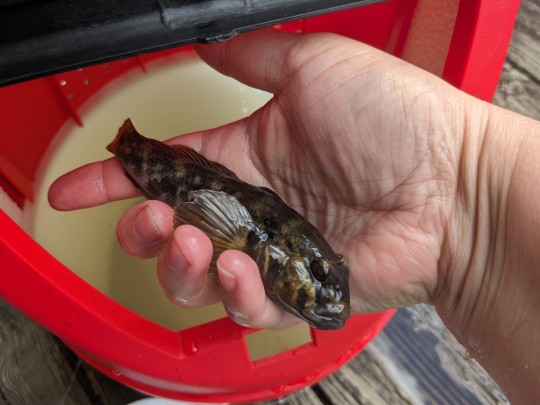
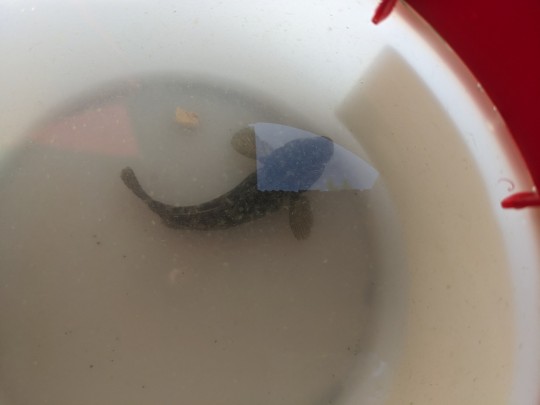
These little fuckers are round gobies. They are a freshwater goby that's invasive in Michigan, and they're in the nearby lake. They're distinct from the four native species due to their fused pelvic fins (middle pic) and a big black dot at the rear of their front dorsal fin. Though some other gobies have spots on their fins, NO Michigan-native species has a fused pelvic fin. These guys are very aggressive feeders and are very good at outcompeting native gobies.
They're also extremely good at stealing bait off big hooks as people on the docks reel in their lines. In particular, the bastard in the bottom photo stole my bait two days ago, so I caught him and filleted him for Bug.
Today, after acquiring smaller hooks, I went back and got 16 more, and educated several other fishers about their invasive nature. I got two turned over to me by others, and caught 14 more myself.
One man wandered over and asked why I was catching them on purpose. It was too much trouble to explain my feelings about invasive species, so I just told him, one of them stole my bait two days ago. He stopped watching my bobber and boggled at me and goes:
"You're doing this for revenge?"
So now there's some guy in town that thinks I am exacting revenge upon fish kind for a single stolen worm.
#personal#stories about ked's life#fish#animal death for ts#Anyway#I'm going to learn how to make fish meal to make peafowl treats#I just killed the ones today and put them out for the crows#Bug stole the smallest one and ran off with it#I don't know if she managed to eat it or not#but I couldn't find it where she was standing “killing” it#so I assume so
7K notes
·
View notes
Text

Two new species of freshwater goby (Teleostei, Gobiidae) from the Upper Youshui River, Chongqing, China
Lingzhen Li, Chaoyang Li, Weihan Shao, Suxing Fu, Chaowei Zhou
Abstract
Two previously unknown species of Rhinogobius have been discovered in the streams of the Upper Youshui River, within the Yuan River Basin, Xiushan County, Chongqing, China. These new species are named as Rhinogobius sudoccidentalis and Rhinogobius lithopolychroma. Phylogenetic analysis based on mitochondrial genomes revealed that R. sudoccidentalis is genetically closest to R. reticulatus, while R. lithopolychroma shares the greatest genetic similarity with R. leavelli. Morphological distinctions allow for the clear differentiation of these species. Rhinogobius sudoccidentalis sp. nov. is characterized by having VI–VII rays in the first dorsal fin and I, 8–9 rays in the second dorsal fin. The longitudinal scale series typically consists of 22–24 scales, while the transverse scale series comprises 7–8 scales. Notably, the predorsal scale series is absent and the total vertebrae count is 12+17=29. Rhinogobius lithopolychroma sp. nov. can be distinguished from other species by the presence of 13–15 rays on the pectoral fin. Its longitudinal scale series ranges from 30 to 33 scales, with no scales in the predorsal area. The total vertebral count is 30, with 12 precaudal and 18 caudal vertebrae. The head and body of this species are light gray with irregular orange markings on the cheeks and opercle. Through morphological and molecular analyses, it has been confirmedthat R. lithopolychroma and R. sudoccidentalis represent novel species within the Rhinogobius genus.
Read the paper:
Two new species of freshwater goby (Teleostei, Gobiidae) from the Upper Youshui River, Chongqing, China (pensoft.net)
207 notes
·
View notes
Text
Freshwater goby, freshwater strength, freshwater head of unusual length
84 notes
·
View notes
Text
It's the last day of Mermay...
So have my most common headcanons on who would be which (or take inspiration from such) for if they were merfolk <3 Yes, this is DCxDP but can be used for either separately if you want.
Bruce- Ray
Alfred- Remora
Kate- Angel Shark
Dick - Guppy
Cass- Cuttlefish
Jason- Thresher Shark
Tim- Bichir
Steph- Spanish Shawl Sea Slug
Duke- Anglerfish
Harper- Cichlid
Cullen- Rasbora
Damian- Stingray
Carrie- Dusky Batfish
Jarro- Starfish
Terry- Devilfish
Matt- Koi
Barbara- Jellyfish
Gordon- Squirrelfish
Ghostmaker- Moray Eel
Harvey- Tiger Shark
Selina- Catfish
Harley- Clownfish
Poison Ivy- Leafy Seadragon
Riddler- Corydoras
Joker- Piranha
Bane- Pufferfish
Mr. Freeze- Leopard Seal
Scarecrow- Anglerfish
Waylon- Saltwater Crocodile
Solomon Grundy- Coelacanth
Penguin- Longfin Icedevil
Ras Al Ghul- Sturgeon
Talia- Pike
Dusan- Pike
Deathstroke- Tiger Barb
Clark- Sea Lion
Connor- Fur Seal
Jon- Fur Seal
Kara- Sea Lion
Martha Kent- Ribbon Seal
Jonathan Kent- Manatee
Lex Luthor- Cardinalfish
Barry Allen- Marlin
Wally West- Swordfish
Bart- Marlin
Iris- Trout
Thawne- Wahoo
Captain Cold- Beluga Whale
Heatwave- Guppy
Captain Boomerang- Discus Fish
Mirror Master- Mahi Mahi
Green Arrow- Goby
Arsenal- Arapaima
Artemis- Grouper
Black Canary- Orca
Diana- Lionfish
Cassie- Lionfish
Cheetah- Spotted Snapper
Vandal Savage- Dunkleosteus
Marvel- Whale Shark
Billy- Wrasse
Mary- Wrasse
Freddy- Killifish
Eugene- Loach
Pedro- Danio
Darla- Goby
Black Adam- Gar Fish
Dr. Sivana- Dolphin
Mister Mind- Bristle Worm
Martian Manhunter- Octopus
M’gann- Octopus
Aquaman- Hammerhead Shark
Kaldur- Blue Tang
Oceanmaster- Ray
Plasticman- Oarfish
Booster Gold- Goldfish
Blue Beetle- Blue Shrimp
John Stewart- Sailfish
Hal Jordan- Neon Tetra
Red Tornado- Mantis Shrimp
Zatanna- Swordtail
Constantine- Fighting Fish
Doctor Fate- Wrasse
Deadman- Glass Fish
Klarion- Platy
Cyborg- Mola
Raven- Squid
Beast Boy- Triggerfish
Starfire- Koi Fish
Beast Boy- Fluffy Sculpin
Lobo- Wolf Fish
Deadshot- Ruby Barb
Killer Frost- White Koi
King Shark- Great White Shark
Doctor Light- Dolphin
Catman- Tigerfish
Angel Breaker- Redtail Black Shark
Trigon- Giant Squid
Martha Wayne- Mako Shark
Thomas Wayne- Devil Ray
Lucious Fox- King Mackeral
Jack Drake- Freshwater Angelfish
Janet Drake- Comet Goldfish
================================================
Danny- Betta Fish (Or Giant Phantom Jelly)
Dan- Lancetfish
Ellie- Betta Fish
Jazz- Oarfish
Sam- Lamprey
Tucker- Devil's Hole Pupfish
Valerie- Cherry Shrimp
Vlad Masters- Vampire Squid
Maddie Fenton- Lion's Mane Jelly
Jack Fenton- Whale
Ida Manson- Gulper Eel
Mr. Lancer- Hatchetfish
Spike- Gourami
Wes Weston- Carp
Kyle Weston- Perch
Paulina- Dragonfish
Star- Cichlid
Dash Baxter- Short Beaked Dolphin
Kwan- Goldfish
Box Ghost- Boxfish
Lunch Lady- Killifish
Skulker- Sea Turtle
Ghostwriter- Lyretail
Sidney Poindexter- Shubunkin
Jonny 13- Corydora
Kitty- Loach
Ember- Basslet
Desiree- Seahorse
Spectra- Eel
Walker- Frogfish
Nocturn- Lanternfish
Overgrowth- Sea Pig
Fright Knight- Swordtail
Pariah Dark- Skate
Princess Dora- Dragon Goby
Pandora- Leaf Scorpionfish
Frostbite- Crabeater Seal
Clockwork- Colossal Squid (or Congor Eel)
------------------------------------------------------------------------------If you want pics of any of the fish/creatures I am happy to put them out, I just can't put that many links on one post lol. (Also apologies if I missed anyone)
#if you just wanna ramble with me I am So Down#dcxdp#dpxdc#mer au#merfolk#mermay#merpeople#merperson#merman#mermaid#happy mermay#prompts?#prompts#headcanon?#headcanon#dc#dcu#danny phantom#danny phantom crossover#dc crossover
62 notes
·
View notes
Text
When I first heard that a new Endless Ocean was going to be released, I was incredibly excited. Just absolutely over-the-moon excited. You see, Endless Ocean 2: Blue World (also called Endless Ocean 2: Adventures of the Deep) is one of my favourite games of all time. Scratch that: it is my favourite game. It was far from perfect, but I loved it dearly and happily sank hundreds if not thousands of hours into it.
EO2 is a diving game for the wii that was released in 2010, and I have never been able to find a game quite like it. The main story was a bit cheesy, but charming and engaging, with a bevy of likeable if occasionally one-note characters, and the game itself had surprising depths (diving pun fully intended). The game had 12 different diving maps in 6 locations and while the specific areas were fictitious, they were based on very real places (the South Pacific, Mediterranean Sea, Red Sea, Arctic and Antarctic Oceans, as well as a freshwater river in the Amazon) and this was reflected in the species found in each area, with a few exceptions here and there. You could explore shallow coral reefs, a sunken castle, ancient temples, abyssal depths, a kelp forest, sandy beaches, riverbanks, hidden coves with murals, and much more. You also had a small private island as a hub location, a personal reef you could decorate, and a public aquarium which you could fill with any of the non-legendary species you discovered.
Speaking of which, the game featured 340 different species of marine and freshwater fish, sharks, rays, marine mammals, penguins, shore birds, reptiles, crustaceans, cephalopods and other invertebrates. Some of these also had different models for young or different genders. You could find truly miniscule species that most other diving games overlook entirely in zoom-spots (such as gobies and nudibranchs), and you could interact with most by feeding, touching or even riding in the case of large marine life. And on top of this you could also find legendary creatures, which could be individuals of extant species with unusual colouring or size, or even extinct species, and could be exceedingly hard to find but entirely rewarding.
This is already getting to be much too long but on top of all this you could customize your diver character, buy things for your island hub, decorate and populate a private reef to propagate and release fish, create various aquarium exhibits, discover a great many side-quests, upgrade equipment, take and sell photographs, heal sick animals, search for and sell salvage, find collectable coins, train dolphin partners, take requests for guided tours, dolphin shows, salvage and photos, dodge or placate aggressive sharks, and more that I am probably forgetting. It’s been a while since I’ve played the game, as I no longer have a wii and don’t have the first clue on how to emulate games on my PC. All this is to say that this game was something special, and I have never been able to find anything remotely close to it. And seeing as how the last one was released almost 15 years ago, I had long given up hope for an Endless Ocean 3.
And then lo and behold, a trailer dropped from out of nowhere for Endless Ocean Luminous! And it was releasing in a month! Holy Shit! What!? Yes!
But alas, the more information came out about the game, the more that excitement started to wane. A focus on multiplayer? Procedural generation? Only one map? The only character being an AI that sounded like all those awful tiktok voices? To be clear, I wasn’t expecting Luminous to be the next GoTY. I wasn’t even expecting it to be an exact replica of EO2, or continue the storyline. If it had even a fraction of what I liked about the previous game I was going to be one happy camper. I assumed that the marketing was focusing on the multiplayer aspect instead of the single-player story, that hopefully the procedurally generated map was exclusive to that multiplayer. Surely the single player mode would extend past what little was shown in the trailers. Some things seemed promising, such as an advertised 500+ species, and even more prehistoric marine life. But again, alas, what I have seen since the release is the barest and palest reflection of what I enjoyed about the previous game. I could understand cutting some content, such as the dolphin training and shows, considering the controversy of cetaceans in captivity. But it seems like there is no aquarium, no central hub of any type, no characters beyond the aforementioned AI and a single faceless diver, salvage reduced to a single click, an incredibly reduced story consisting mostly of scanning fish, no ability to feed or interact with fish and fish behaviour also seems to be quite reduced. At least photography still appears to be in the game, though its unclear to what point. Are there still photo requests? The ability for some critters to swim along with or attach to your diver looks cute at least. But everything I’ve watched so far just feels so… lifeless. Empty. As if the whole game was AI generated, which I’m at least %75 sure isn’t the case.
But I’m left kind of baffled by the direction that this game was taken in. I’ve been trying to find any information about it’s development with little to no success. Why the focus on multiplayer to the exclusion of a single player story beyond the bare minimum? What lead to the choice to have a single, procedurally generated map instead of separate, smaller, but more scientifically accurate maps? Or even a single smaller but purposefully designed map? Was this game more like the previous games at any point in its conception or development or was it always intended to be such a departure?
#I apologize for the wall of text and stream of consciousness rant#Should this game ever go on sale I may check it out#but as it is I cannot justify spending $50 on it#endless ocean#endless ocean 2#endless ocean luminous
32 notes
·
View notes
Text
Spectember D26: Break a biological record

Some hundreds of millions of years far into the future around 300 million years hence, after the formation of a big supercontinent, one that was not predicted to form, a lot of existing terrestrial and marine fauna look so alien compared to the animals that once man witnessed as the difference is as much as a human being would have to the first terrestrial tetrapod. Phylogenetically speaking many of those animals would be related to something like a crown, a snake, a varanid, a goby, a frog, a bat and so on but they are totally anatomically, morphologically and physiologically far from those, mammals and birds are a fraction of what they were, more mole or reptile like, varanids and frogs suffered of varied radiations and now they have been as much diverse as how dinosaurs and synapsids went through the Mesozoic and Cenozoic, and small fishes survived and radiated from freshwater species over and over from different mass extinctions, and just for matter of convergence they looked something like the modern species man saw, but they aren’t anatomically close to those.
In land mammals are just small and ectothermic creatures, in the ocean however one lineage managed to thrive as large swimmers, is not like any other group however, they have lost their forelimbs, their tails barely help them to swim and often depending of the species they have a rigid fluke or a seahorse-like prehensile tail, they managed to re-evolve some structure similarly to gills from a part of a nose cavity, a result of its proper ontogenic development as they did born not fully developed. These aren’t descendants of placentary mammals, but marsupials, a lineage that stood almost unchanged for many dozens of millions of years in the Americas and took a turn after the major calamities through the last 200 million years that drove their group to become reptile like, adopt peculiar adaptations for their lethargic metabolism and ended up in this stage, these aquatic animals were the last descendants of the opossums.
The Scorn Figoeq are a twisted form of the more seahorse-like herbivorous relatives that lives in the surfaces, living at depths of 4000 to 5000 meters under the surface is by far the deepest species of tetrapod that has ever lived, the deepest mammal to have diver so low under the ocean. It adopted the lifestyle of the already gone anglerfishes as well some other deep-water fishes, is among the last of an experimental lineage of the Figoeqs (Derivation of Figoeqqus or "shaped like horse") that tried to become pelagic planktonic feeders which ended up becoming extinct in the last 50 million years, remaining as a relic of that group. With 25 cm long, anything that could be considered mammal like only is exposed by looking at the embryo of this species as it starts with the basics of mammal anatomy, but reaching adulthood they resemble a mix of a jelly and a bizarre abyssal fish, with their short body, large head with a deep gelatinous cover that protects part of its head and eyes that now grow inside the flesh, with long dorsal spines that helps it to stabilize while swimming, their long hind flippers that look more like ray fins, and the tail that has grow a fluke to push it slowly across the darkness of the abyss.
61 notes
·
View notes
Text
MONSTROUS FUSION LINKS AS FISH AND OTHER AQUATIC CREATURES IF MONSTROUS FUSION WERE FISH OR OTHER AQUATIC CREATURES
All characters belong to @monstrous-fusion!!! This is my other mermay contribution. Each Link has a different place in the world of cultural inspiration, so at least one of the fish included for each is endemic to that region. Endemic means it is native to that specific area and not found (naturally) anywhere else in the world!! It’s really cool. There are some fish that are endemic to a singular lake!!!! Big lakes, but still one singular lake!!!! Or one reach of a tributary stream!!! It’s super cool.
Anyway. FISH!!!!! Image descriptions at the very bottom! :D




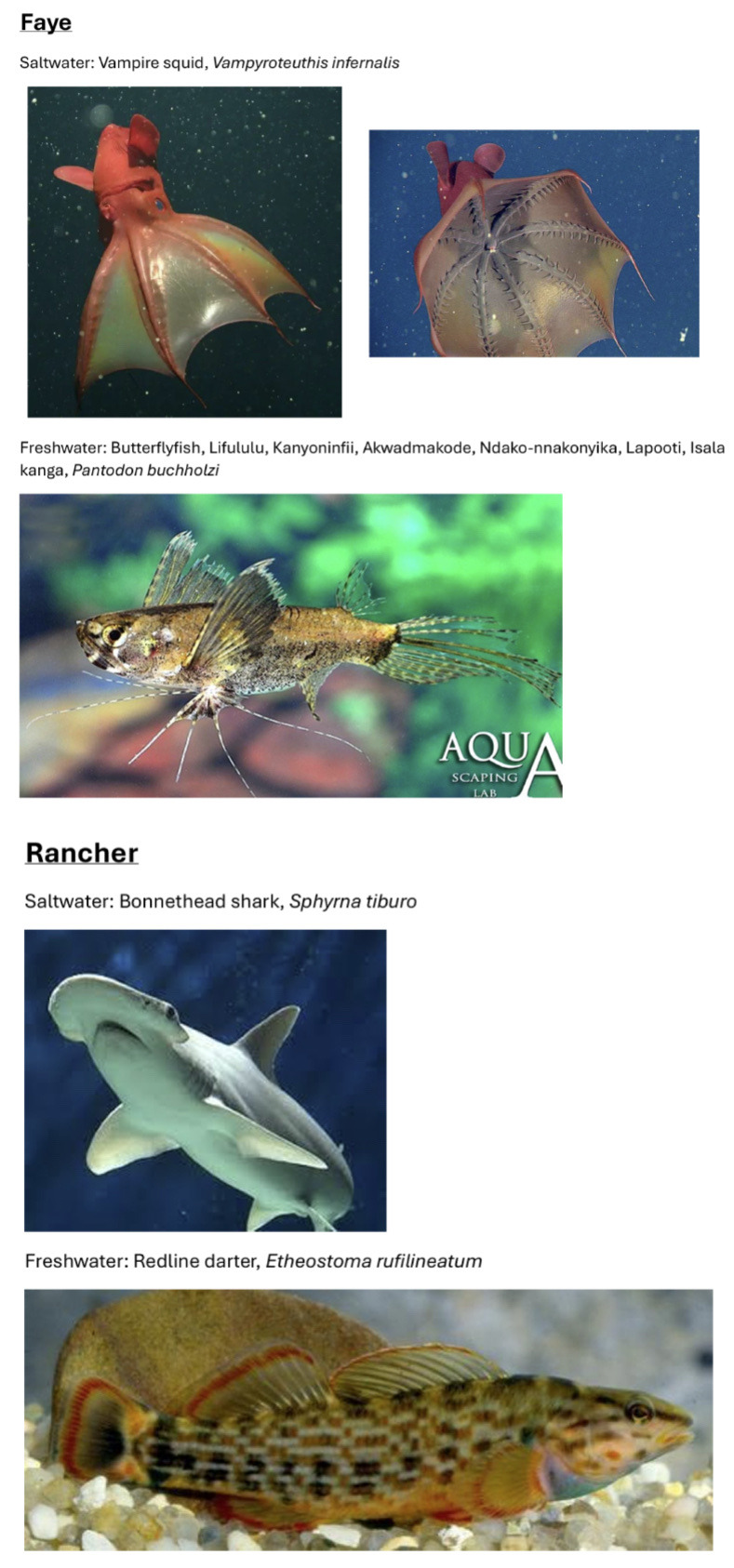
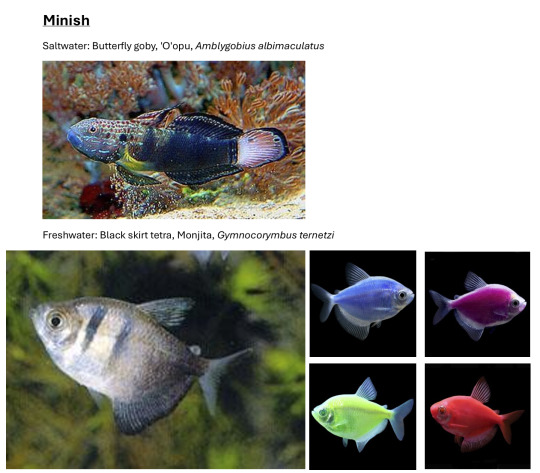
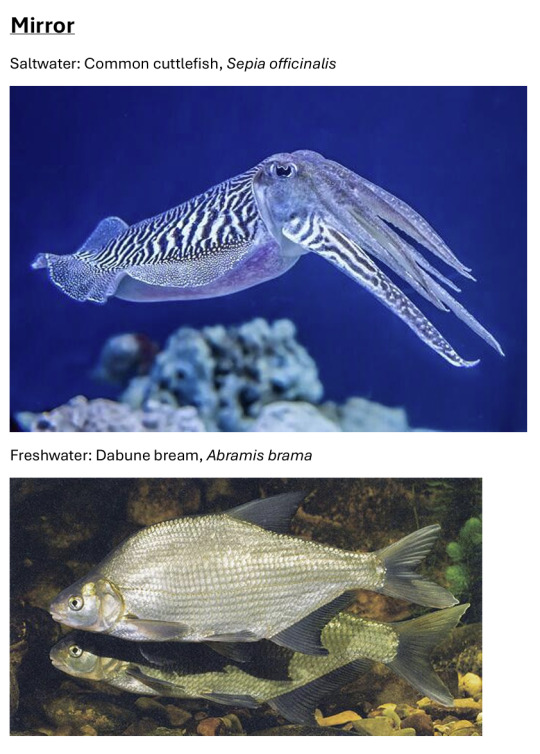
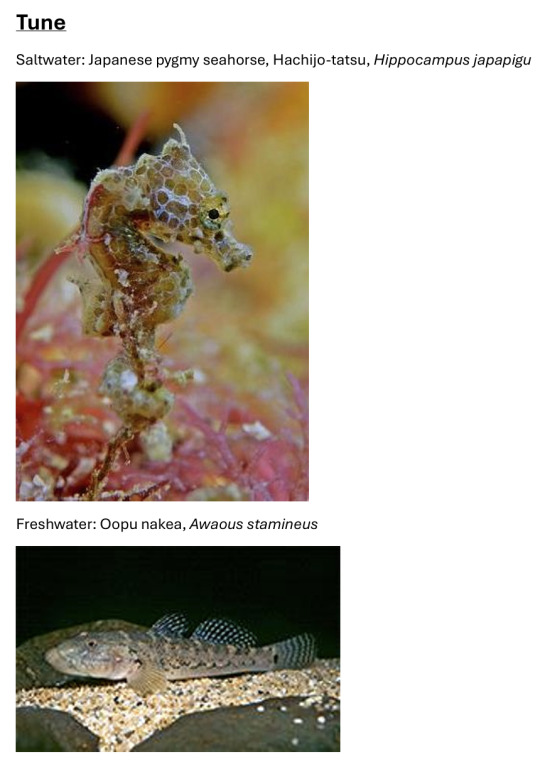
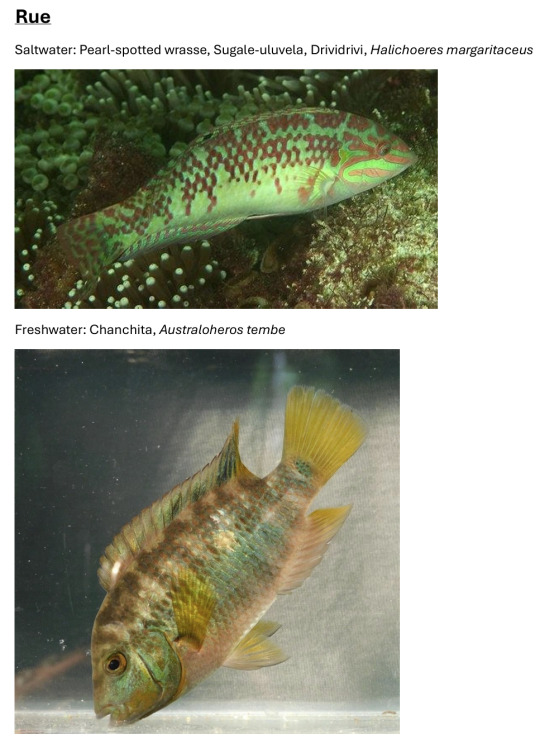
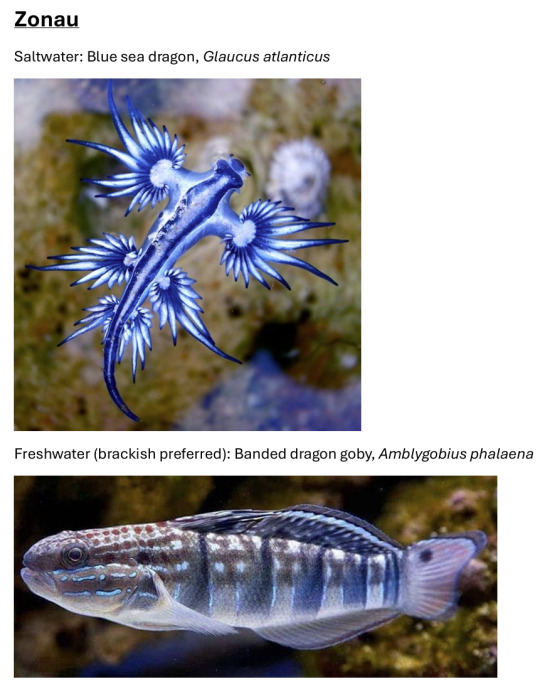
IMAGE ID: Images are the names of each link and then a saltwater fish and a freshwater fish. Each fish has the common name, the common name in the native language of wherever it is found, and then the scientific name. The fish are listed below. Since I am posting this on mobile I only have an English keyboard, so I am only including the common names in the ISO Latin alphabet in the descriptions.
Artisan. Saltwater: Transparent goby, Aphia minuta. Freshwater: Blue discus, Acará disco azul, Symphysodon aequifasciatus.
Engie. Saltwater: Blackspot tuskfish, Marigyan, Mugadyi, Nggalanggari, Choerodon schoeleinii. Freshwater: Doumea reidi.
Eras. Saltwater: Whale shark, Rhincodon typus. Freshwater: Evia barbel, Petropsaro, Barbus euboicus.
Faye. Saltwater: Vampire squid, Vampyroteuthis infernalis. FreshwaterL Butterflyfish, Lifululu, Kanyoninfii, Akwadmakode, Ndako-nnakonyika, Lapooti, Isala kanga, Pantodon buchholzi.
Rancher: Saltwater: Bonnethead shark, Sphyrna tiburo. Freshwater: Redline darter, Etheostoma ruffilineatum.
Minish: Saltwater: Butterfly goby, ��O’opu, Amblygobius albimaculatus. Freshwater: Black skirt tetra, Monjita, Gymnocorymbus ternetzi.
Mirror. Saltwater: Common cuttlefish, Sepia officinalus. Freshwater: Dabune bream, Abranis brama.
Tune. Saltwater: Japanese pygmy seahorse, Hachijo-tatsu, Hippocampus japapigu. Freshwater: Oopu nakea, Awaous stamineus.
Feathers. Saltwater: Blotchwing flyingfish, Peshk fluturues, Rundinella, Uçan balik, Cheilopogon heterurus. Freshwater: Van loach, Oxynoemacheilus ercisianus.
Rue. Saltwater: Pearl-spotted wrasse, Sugale-uluvela, Drividrivi, Halichoeres margaritaceus. Freshwater: Chanchita, Australoheros tembe.
Wild. Saltwater: Ornate cowfish, Arcana ornata. Freshwater: Blunt-nosed Irish charr, Salvelinus obtusus.
Zonau. Saltwater: Blue sea dragon, Glaucus atlanticus. Freshwater (brackish preferred): Banded dragon goby, Amblygobius phalaena.
/END ID.
15 notes
·
View notes
Text
The Hong Kong goby
Rhinogobius duospilus (formerly R. wui) and its species complex, are among the more popular aquarium gobies for freshwater tanks. True R. duospilus grow to 4 centimeters, or over 1 and a 1/2 inches, and are traded as dwarf dragon, red-cheeked or especially Hong Kong gobies. It is unlikely that great effort will have been made, to accurately identify the fish at species level.
In the aquarium, R. duospilus favors a, water temperture, of 16 to 25 degrees centigrade. Although these subtropical gobies are sometimes described as coldwater fishes, in fact they rarely experience tempertures below 15 degrees in the wild. This species has a broad tolerance of pH and hardness values, but the water must be well oxygenated.
This is because R. duospilus inhabits brook environments, where it is sympatric with hillstream loaches, such as Beaufortia. These are freshwater environments, above the influence of the tides, so no salt should be added to the water. A pH of 5.6 to 6.4 might be inferred from the origins of R. duospilus.
Two male Rhinogobius will be mutually antagonistic, although the females show no such difficulties, and several may be housed per male, to create a social environment. Rhinogobius are simply disinterested in any tankmate that is neither food nor a threat. Feeding R. duospilus is a matter of provisioning defrosted, meaty, invertebrate-based food for them. Unlike some freshwater goby species met in the trade, such as members of Stiphodon, the species belonging within Rhinogobius are carnivorous.
#Rhinogobius duospilus#Hong Kong goby#red cheeked goby#dwarf dragon goby#freshwater gobies#oddballs#coldwater tropicals
0 notes
Text

My little guy (scarlet badis) shows his face (bonus appearance by baby snails and a bumblebee goby).
#nano fish#nano aquarium#scarlet badis#bumblebee goby#tropical aquarium#tropical fish#freshwater aquarium#freshwater fish
1 note
·
View note
Note
I'm a bit shy asking this so I'll stick to anon for the time being. I visited a pet store today and they had the cutest little fish roaming at the bottom of one of their tanks gulping and spitting out sand. I couldn't find the species on the side with the names and tried to do some research and I think it may be a Sand Sifting Goby? All I saw was that they require salt water and that it seemed to feed off whatever was in that sand. I'm genuinely obsessed with this little guy and took plenty of videos, but I don't want to make bad decisions and get one without proper knowledge and research. I was curious to know if you had any facts or tips to help me out? Thank you 🩷
Sounds adorable!! Sand sifting gobies are a whole group of species that come in a variety of colours, all of them looking quite sweet! No doubt the fish was captivating to look at doing its little sand sifting :D
You say you do not wish to make a bad decision and simply impulse buy one without research, which is a good mindset to start from. Fish are not a monolith of animals, they're a large and diverse group of species, each one having their own specific criteria for keeping. I don't know if you've kept fish before or not anon, but I will be giving a general explanation that lets a person who hasn't get started: fish require specific water parameters (temperature, pH, general hardness and calcium carbonate concentration, salinity, etc.), substrate (thickness at the bottom, colour, roughness), plants (density of plants, real or fake, etc.), decor (will the decor scratch or accidentally harm the fish, do they like to hide, etc.), tankmates (of their own species or of different species, or lack thereof), food (specific dietary preferences and restrictions), lighting (harsh or dimmed, amount of light a day), so many things! Freshwater and saltwater aquariums are also different and require different equipment.
The very first thing I recommend you do is go to the pet store (or contact them through social media or email) and ask them what species the goby is. This way you can do research on the specific species instead of sifting through general information about all sand sifting gobies, which may be completely different from our dear little friend at the pet store! That's actually the crux of obtaining a fish or another aquatic life companion: RESEARCH! Soooo much research. You must research your finned friend so much it's starting to feel ridiculous and your family is asking you if you're "still planning on that fish or..?". Look up care guides and fish forums, watch YouTube videos, gather up all the information you get. Some of it contradicts itself, which is why it's important to look to many many sources. Try seeing the newest ones and see what parameters and suggestions are most common. That's only the beginning, though: if you've never owned a fish before, you need to learn about all these aquarium-keeping terms and how to maintain an aquarium, what you need for an aquarium, how to cycle it, etc.. Actually, that's probably best to do before you look up care guides, now that I think about it... Or do both at the same time, that's what I did when I was planning my shrimp tank. See beginner's guides to saltwater fishkeeping, on several sites, move onto more advanced guides and learn the terminology. Learn why these parameters matter so much, or why and how to cycle your tank. Weigh the pros and cons of having plants or some plant species, research different substrates, see what tanks and lights and filters are smartest for you, learn about aquarium pests. Try to find a good middle ground for what's sensible for you and what's the best for your pet; we keep animals for our enjoyment, but we also want to make sure they're having their best time too! Make a list for all the items you need, see how much different options cost, make a budget. Research the water parameters of your city or town, or test the water yourself. See what needs to be done to it so it's suitable for your animal. I've never kept a saltwater tank so I don't know the specifics of it myself, but if you wish to be a saltwater aquarium keeper you must learn! It's a lengthy process, but I went through seven months of preparation before I got my dwarf shrimps. This included my research (I don't have an estimate for how many articles and forums I looked through but my "Shrimps" playlist I made in preparation has 52 videos of just cherry shrimp and aquarium-keeping educational videos), shopping for equipment and plants and setting everything up, and cycling my aquarium. Dear folks in my notes also informed me that saltwater tanks and setups tend to be more expensive than freshwater setups!
Maybe at some point you find that the setup and equipment are simply too expensive, or incompatible with your lifestyle or living situation, or you change your mind for another reason during the preparation process. And that's valid and okay! You took the time to learn and what you learned was just that: it wasn't meant to be. It's much better than getting an animal without preparing and only finding out afterwards that you're incompatible in some way. Learning about these things won't be for "nothing" either, as now you have the valuable knowledge of how to keep fish and an aquarium! It may prove useful later in life if you eventually do obtain an aquarium, or you can become the resident fish knower (very rewarding). You may also decide to look into freshwater gobies, as they are gobies all the same but easier to care for! Please take a look at the folks in the notes and their lovely info.
Hope this helps anon! Perhaps you were wishing for a fish facts -format post, but my measly one-to-four sentence daily fish facts do not a species expert make. Instead I want to give out a guide on how to get started on your goby-keeping journey. I hope it works out for you, I wish you good luck! :)
52 notes
·
View notes
Note
whats ur fav fish :3
My fave fish is the coelacanth for sure. But that's neither a native fish, nor suitable for a fish tank so that's not a fun answer! I'm gonna infodump on my fave native fishes below!
Starting with the iconic Sunfishes - so many to love! Orangespotted Sunfish are probably my favorite in Lepomis for their beauty, small size, and peaceful nature (Warmouths are second in this genus). I also love my Bluespotted Sunfish for many of the same reasons, and there's a part of my that find Fliers infinitely interesting. They look like Lepomis/Pomoxis hybrids and I love them.
The Fundulus killifishes are all fantastic. Mummichogs have been among my favorite fishes kept, but Banded, Longnose, Seminole, Marsh, Striped, and Gulf killies are all hardy, with subdued beauty.
Despite all the invasive species, we only have one native Cichlid, the Rio Grande/Texas Cichlid - a real beauty of a fish that is a typical pugnacious American cichlid and is relatively easy to place in aggressive communities.
Darters are so cool - they are so unlike many of the fish you see in stores and are behaviorally fascinating. We have SO MANY beautiful darters like Greenside and Candy darter complexes, but my vote is for Tesselated. Because I can find those locally. Fun fish for sure.
Pretty much every Pike is a solid choice - but the Esocidae family also includes Mudminnows! Described as "cigars with fins" they are supremely cool fish that are small and peaceful - their moving of all fins out of sync to stay hovering in the tank column is a treat to watch.
Similarly, every Gar is fantastic in my book, with my vote going to the Longnose Gar for its impressive range and salinity tolerance.
Our minnows are winners, hands down, with both the silvery ones and the colorful ones being awesome fish. Lots of great choices for tank keeping too. But I'm going with the Mountain Redbelly Dace here. Beautiful fish for sure!
Mosquitofish are comforting. Around here, you find them EVERYWHERE. I typically catch a few no matter where I fish. They look like Guppies without the vivid colors, but most still get some pleasant iridescence to them and in Florida you can find lovely black and white mottled variants that are just so cool.
Our native freshwater catfishes are cool but I love our saltwater catfishes. Called crucifix fishes for the shape of their skull bones, both the Gafftopsail and Hardhead Catfishes are neat social animals with a wide salinity tolerance.
The gobies are a family of winners as far as I'm concerned but the Violet Goby takes the cake for being a MEGA weirdo - this nearly two foot long fish wouldn't hurt a fly (a fry?) and so so so odd. Who wouldn't love them?
Atlantic Spadefish may not have the great juvenile coloration of their Platax relatives, but they are smarty pants fish that get big and are very active. I've seen populations in the Georgia Aquarium that are spellbinding to watch.
Hogchokers are Soles that have a terrible name but are also the most common fish in the Chesapeake Bay. I'd love to catch one someday!
I feel like I should stop here - but how do you not include our native puffers, bowfins, madtoms, damselfish, morays, salmon, sturgeon, Mollies, Pupfish, or Angelfish? We have one native tetra too! Isn't that neat?
18 notes
·
View notes
Note
Heya! Any creature reccomendations for 1.015-1.017 salinity levels? Have got a mega paludarium at that salinity level over the last couple years- the denizens being some sailfin mollies, endlers, picta guppies, bbg’s, Marbled limpets, a stray ghost shrimp, a handful of tiny local PNW shore crabs, a batch of fiddlers, and a big fat dragon goby named Grumbo.
All have been living (and,,,quite prolifically breeding) in great health since early ‘23, but I’m left to wonder- any other creatures suitable for this community that won’t chow down on the smaller fellas?
I keep my stocking levels <8 individuals of any of the schooling fish at any given time, so as to keep margin open for potential newbies.
(Also, you are the main inspiration behind this megadarium project, so I wanna say thank you as well!!!)
Hey I'm glad you have found brackish fish keeping so rewarding! There are definitely times I wish I had kept my 125 saltwater tank as a brackish one - partially for interest and partially for cost :) but you seem to have an interesting set up.
I do have a few ideas - look into these and see if any float your boat:
If you have a particularly large tank (upwards of 100 gallons) then Scats are some of my favorite centerpiece fish. They are hardy and peaceful given their large size. But in good conditions they can live up to 20 years so, yknow, buyer beware.
Stripies (Microcanthus strigatus) are rare fish in the trade, I've only seen one, but they are very cool fish that are Scat-like in behavior with bolder colors and smaller size.
There are only a scant few damselfish that tolerate brackish water indefinitely - the Sergeant Majors are easy to find but they are bruisers sometimes. I myself have three Freshwater Demoiselle (Neopomacentrus taeniurus) and can't recommend them enough. You typically only find them in batches of "assorted damsels"
There are a few Blue-Eyes species in the family Pseudomugilidae if you are looking for another schooling species. They are small and beautiful - but pricey for a large group.
On the other end of the price spectrum are the North American Fundulidae Killifish. A few of the coastal species can tolerate higher salinities and are fantastic fish for home keeping - Mummichogs, Gulf Killifish, Marsh Killifish, and Diamond Killifish. But finding them for sale is very difficult. The Diamonds are rarely sold and the Mummichog is a laboratory fish that almost never is sold in the aquarium trade - but all are pretty free for the catching if you live in a coastal state and have the desire to catch your own!
Honorable mentions goes to some of the smaller sole species, which may only get up to 3 inches, but I'm uncertain if they would prey on smaller Pictas and Endlers. It's a touch high for them, but in the 1.013 to 1.015 range you might do okay with Orange Chromides, which in nature inhabit higher salinity areas on occasion, along with the related Green Chromides.
Hope that gave you a few ideas!
7 notes
·
View notes
Text
Prefixes/Suffixes for RiverClan Cats
Words from things that can't be found in North America or Europe [or freshwater] aren't included; this list is made based on RiverClan territory, culture, & prey.
110+ prefixes and 30+ suffixes under the cut!
Prefixes
A
Acara-
Alder-
Algae-
Angler-
Azalea-
B
Barbel-
Bass-
Bay-
Beaver-
Beetle-
Bog-
Bowfin-
Bream-
Burbot-
C
Carp-
Catfish-
Chestnut-
Chub-
Cisco-
Clam-
Clay-
Clover-
Creek-
Cod-
D
Damselfly-
Dapple-
Dappled-
Dogwood-
Dragonfly-
Drop-
E
Eel-
Egret-
F
Fern-
Fin-
Flounder-
Flower-
Frog-
G
Gar-
Goby-
Goldenrod-
Goureen-
Grayling-
Gudgeon-
H
Herring-
Huchen-
Hyacinth-
I
Ide-
Iris-
L
Lake-
Lamprey-
Lily-
Loach-
Lotus-
M
Mackerel-
Magnolia-
Mangrove-
Marigold-
Marsh-
Mayfly-
Mink-
Minnow-
Mosquito-
Moss-
Mud-
Muddy-
N
Nase-
O
Oak-
Orfe-
Otter-
Oyster-
P
Pearl-
Peat-
Pebble-
Perch-
Pike-
Pond-
Primrose-
Puddle-
R
Rain-
Ray-
Reed-
Rice-
Ripple-
Rudd-
Ruffe-
Rush-
S
Salmon-
Sander-
Sedge-
Shad-
Shell-
Silt-
Skeeter-
Snook-
Spirlin-
Splash-
Stingray-
Storm-
Stream-
Streber-
Sturgeon-
T
Tadpole-
Tench-
Toad-
Trout-
Turtle-
V
Vendace-
Vimba-
Vine-
Vole-
W
Wave-
Willow-
Suffixes
B
berry
branch
C
creek
D
dapple
dew
drop
droplet
F
fin
fish
flower
G
glimmer
L
lake
leaf
M
marsh
moss
P
pond
puddle
R
rain
ripple
S
scale
shimmer
shine
splash
storm
stream
T
tail
V
vine
W
wave
#warrior names#prefixes#suffixes#/ Region:#North America#Europe#/ Clan:#RiverClan#/ Reach:#TumblrClan#warriors#warrior cats#warriors oc#warriors roleplay#oc inspiration#oc inspo
24 notes
·
View notes